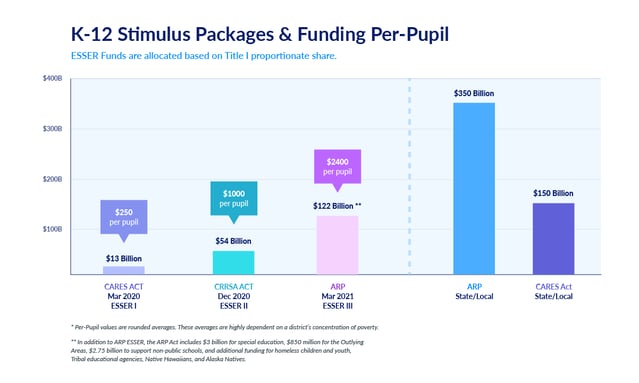ask jess: student-to-teacher ratios?
get real: the messy middle of change management in district finance [webinar]
ask jess: flexible teacher staffing?
clarity & accountability in district finance [webinar]
halftime for esser [webinar]
school leader perceptions about k-12 finance [webinar]
the next 10 years of ed finance: edfintech climbs to new heights
the next 10 years of ed finance: school choice
the next 10 years of ed finance: investing in early childhood
tennessee's student-based k-12 funding formula
the next 10 years of ed finance: state funding formulas
the next 10 years of ed finance: reimagining k-12 real estate
the next 10 years of ed finance: the future of edtech
the next 10 years of ed finance: the great unbundling
the next 10 years of ed finance: pension debt & reform
the next 10 years of ed finance: declining enrollment
the next 10 years of ed finance: teacher compensation
10 year anniversary reflection
meet ryan lee: business development specialist
engaging budget stakeholders with allovue + balancing act
let's talk about vacancies
meet tyler hall: solutions engineer
steering clear of the fiscal cliff
the maryland blueprint: new resource allocation guidelines
funding flexibility: how 3 school districts are using esser
when talking about numbers is speaking a foreign language
getting started with equity-based budgeting
the resource side of the equation—reflections from jess gartner
pivoting to equity-based budgeting using esser funds
esser mythbusting [webinar]
creating an equity vision and planning for equity-based budgeting
meet josh barillas: implementation manager
equity-based budgeting: 5 questions to consider
strategic stimulus spending for pennsylvania administrators [webinar]
transparency vs. trust in district finance [webinar]
strategic esser spending | abcs of i, ii, iii
new mexico school finance reform (yazzie/martinez)
the education finance guide to understanding essa
better than equal: building equitable resource allocation models
building better budget managers
education finance glossary
predictions for the future of the cfo role under essa
how school budgets are made
how state & local dollars fund public schools
three faqs about esser funds
equitable staff- & student-based resource allocations
revising how your district allocates dollars to schools in 3 phases
where does education funding come from and how is it spent?
spending audits for budget efficiency & equity [webinar]
how to project funding models and enrollment within your district
meet laura nord: vp of sales
how design impacts your financial data
meet allovue: meghan stanton, account advisor
what it takes to run schools & districts in 2020 [webinar]
what is your best quaran-complishment?
the cost of covid-19 for schools & families: part 3
the cost of covid-19 for schools & families: part 2
the cost of covid-19 for schools & families: part 1
behind the scenes of a recession in k12
trust, but verify: what to ask your finance team
safeguarding savings: tips to prepare for revenue reductions
how states count students to determine funding: a call for change
transparency & crisis management with superintendent mark schwarz
"i don’t see what school finance has to do with equity."
addressing equity in a budget crisis [webinar]
democratization of financial data in large districts [webinar]
guide to implementing priority-based budgeting in school districts
streamline district spending by offloading ineffectual programs
achieve district goals with strategic budgeting
meet allovue: jess gartner, ceo
is a student-based allocation funding formula right for your district?
what is zero-based budgeting?
survive district accounting system transitions with allovue
5 steps to transition your district to weighted student funding
meet allovue: jessica garrett, vice president of people
better data, better decisions: meet 'power user' jordan ely
the future of education finance summit 2018: a recap
centralized vs. decentralized budgeting: strategies to advance equity
meet your k-12 budgeting season survival guide
go the extra mile: 3 ways to use essa report cards to improve schools
improve district financial transparency in five key areas
the a, b, cs of back to school finance
pop quiz: four questions to gauge per-pupil spending
a day in the life: principal at center for inquiry school 70
using district peer comparisons to drive strategic action
what is the doed's student-centered funding system pilot?
successfully managing budget expenses throughout the year
meet allovue: maggie lubberts, director of product management
establishing financial accountability in your k-12 district
meet allovue: jake mauer, director of design
collaboration: the key ingredient to building & managing k-12 budgets
conducting mid year budgeting and spending reviews
meet allovue: jason becker, chief product officer
trick or treat? what's lurking in your school finances?
how are public schools funded?
meet allovue: cory edmonds, vp of district partnerships
implementing a new funding model in a k-12 district
the importance of personnel costs in deficit analysis
who has control of money in schools?
8 things to consider to improve your k-12 budgeting process
the future of education finance summit 2017: a recap
4 spending mistakes you're probably making at your school or district
understanding school district budget deficits
the 5ws of year end financial reviews
preparing k-12 district leadership for financial reporting under essa
3 steps to make your financial data essa-compliant
looking back to plan ahead
school finance is a civil rights issue
4 ways to measure k-12 instructional program success
achieving equity using average teacher salary
top 10 things superintendents need to know about education finance
how student-based budgeting is revolutionizing special education
ask jess: student-to-teacher ratios?
get real: the messy middle of change management in district finance [webinar]
ask jess: flexible teacher staffing?
clarity & accountability in district finance [webinar]
halftime for esser [webinar]
school leader perceptions about k-12 finance [webinar]
the next 10 years of ed finance: edfintech climbs to new heights
the next 10 years of ed finance: school choice
the next 10 years of ed finance: investing in early childhood
tennessee's student-based k-12 funding formula
the next 10 years of ed finance: state funding formulas
the next 10 years of ed finance: reimagining k-12 real estate
the next 10 years of ed finance: the future of edtech
the next 10 years of ed finance: the great unbundling
the next 10 years of ed finance: pension debt & reform
the next 10 years of ed finance: declining enrollment
the next 10 years of ed finance: teacher compensation
10 year anniversary reflection
meet ryan lee: business development specialist
engaging budget stakeholders with allovue + balancing act
let's talk about vacancies
meet tyler hall: solutions engineer
steering clear of the fiscal cliff
the maryland blueprint: new resource allocation guidelines
funding flexibility: how 3 school districts are using esser
when talking about numbers is speaking a foreign language
getting started with equity-based budgeting
the resource side of the equation—reflections from jess gartner
pivoting to equity-based budgeting using esser funds
esser mythbusting [webinar]
creating an equity vision and planning for equity-based budgeting
meet josh barillas: implementation manager
equity-based budgeting: 5 questions to consider
strategic stimulus spending for pennsylvania administrators [webinar]
transparency vs. trust in district finance [webinar]
strategic esser spending | abcs of i, ii, iii
new mexico school finance reform (yazzie/martinez)
the education finance guide to understanding essa
better than equal: building equitable resource allocation models
building better budget managers
education finance glossary
predictions for the future of the cfo role under essa
how school budgets are made
how state & local dollars fund public schools
three faqs about esser funds
equitable staff- & student-based resource allocations
revising how your district allocates dollars to schools in 3 phases
where does education funding come from and how is it spent?
spending audits for budget efficiency & equity [webinar]
how to project funding models and enrollment within your district
meet laura nord: vp of sales
how design impacts your financial data
meet allovue: meghan stanton, account advisor
what it takes to run schools & districts in 2020 [webinar]
what is your best quaran-complishment?
the cost of covid-19 for schools & families: part 3
the cost of covid-19 for schools & families: part 2
the cost of covid-19 for schools & families: part 1
behind the scenes of a recession in k12
trust, but verify: what to ask your finance team
safeguarding savings: tips to prepare for revenue reductions
how states count students to determine funding: a call for change
transparency & crisis management with superintendent mark schwarz
"i don’t see what school finance has to do with equity."
addressing equity in a budget crisis [webinar]
democratization of financial data in large districts [webinar]
guide to implementing priority-based budgeting in school districts
streamline district spending by offloading ineffectual programs
achieve district goals with strategic budgeting
meet allovue: jess gartner, ceo
is a student-based allocation funding formula right for your district?
what is zero-based budgeting?
survive district accounting system transitions with allovue
5 steps to transition your district to weighted student funding
meet allovue: jessica garrett, vice president of people
better data, better decisions: meet 'power user' jordan ely
the future of education finance summit 2018: a recap
centralized vs. decentralized budgeting: strategies to advance equity
meet your k-12 budgeting season survival guide
go the extra mile: 3 ways to use essa report cards to improve schools
improve district financial transparency in five key areas
the a, b, cs of back to school finance
pop quiz: four questions to gauge per-pupil spending
a day in the life: principal at center for inquiry school 70
using district peer comparisons to drive strategic action
what is the doed's student-centered funding system pilot?
successfully managing budget expenses throughout the year
meet allovue: maggie lubberts, director of product management
establishing financial accountability in your k-12 district
meet allovue: jake mauer, director of design
collaboration: the key ingredient to building & managing k-12 budgets
conducting mid year budgeting and spending reviews
meet allovue: jason becker, chief product officer
trick or treat? what's lurking in your school finances?
how are public schools funded?
meet allovue: cory edmonds, vp of district partnerships
implementing a new funding model in a k-12 district
the importance of personnel costs in deficit analysis
who has control of money in schools?
8 things to consider to improve your k-12 budgeting process
the future of education finance summit 2017: a recap
4 spending mistakes you're probably making at your school or district
understanding school district budget deficits
the 5ws of year end financial reviews
preparing k-12 district leadership for financial reporting under essa
3 steps to make your financial data essa-compliant
looking back to plan ahead
school finance is a civil rights issue
4 ways to measure k-12 instructional program success
achieving equity using average teacher salary
top 10 things superintendents need to know about education finance
how student-based budgeting is revolutionizing special education




